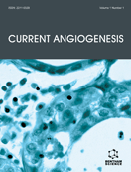Abstract
Angiogenesis can be described as a dynamic, hypoxia - stimulated and growth factor - dependent process, and the term should be specifically referred to as the formation of new blood vessels from pre-existing ones. Literature data coming from either experimental and clinical studies have reported the occurrence of hepatic angiogenesis in conditions of chronic liver diseases (CLDs) characterized by perpetuation of cell injury and death, inflammatory response and progressive fibrogenesis. In the scenario of CLDs hepatic angiogenesis has been proposed to favour fibrogenic progression of the disease, whatever the aetiology, towards the end-point of cirrhosis and related complications. Accordingly, angiogenesis and related changes in liver vascular architecture can concur to increase vascular resistance and portal hypertension, to decrease parenchymal perfusion as well as to modulate the genesis of portal-systemic shunts and increase in splanchnic blood flow. These changes can significantly affect complications of cirrhosis and are also believed to be critical for the growth and progression of hepatocellular carcinoma (HCC). Anti-angiogenic experimental strategies have been shown to limit the progression of animal models of CLDs and anti-angiogenic therapy is currently debated as a new, potentially effective, way for pharmacological intervention in patients with advanced fibrosis and cirrhosis. Finally, recent literature has identified cellular and molecular mechanisms governing the cross talk between angiogenesis and fibrogenesis, with a specific emphasis on the crucial role of hypoxic conditions and reactive oxygen species (ROS) and a research focus on the role of hepatic myofibroblasts in their activated pro-fibrogenic phenotype.
Keywords: Hepatic angiogenesis, liver fibrogenesis, progression of chronic liver disease, hepatic myofibroblasts, hypoxia, reactive oxygen species, pro-angiogenic cytokines.
 19
19

